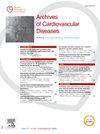Assessment of tricuspid annulus in children with CHD using 3D echocardiography
IF 2.3
3区 医学
Q2 CARDIAC & CARDIOVASCULAR SYSTEMS
引用次数: 0
Abstract
Background
The tricuspid annulus (TA) in children with congenital heart diseases (CHD) may undergo significant changes in size, shape, and function due to hemodynamic overload.
Objectives
This study aimed to compare TA remodeling in children with CHD, based on the type of right ventricle (RV) overload, using three-dimensional transthoracic echocardiography (3D-TTE).
Methods
We enrolled 30 patients with pre-tricuspid overload (atrial septal defect and partial anomalous pulmonary venous connection), 33 with post-tricuspid overload (pulmonary regurgitation after right ventricular outflow tract surgery), and 27 healthy controls. Using 3D-TTE, we assessed the dimensions of the right chambers, the surface area, and the tenting volume of the TA and analyzed the correlation between these measurements.
Results
3D TA surface was larger in the pre-tricuspid group than in the post-tricuspid group (median 6.60 cm2/m2 versus 5.16 cm2/m2, P = 0.01) and was correlated to right atrial (RA) volume (P = 0.0001, r = 0.66) and RA surface (P < 0.0001, r = 0.74) in the pre-tricuspid group. The tenting volume was greater in the post-tricuspid group than the control group but did not differ significantly between the pre-tricuspid and the post-tricuspid groups and between the post-tricuspid group and the control group. 3D TA surface and tenting volume were not correlated to RVEDV in none of the groups (Figs. 1–3).
Conclusion
3D modeling of the TA using 3D-TTE is feasible and provides insights into TA remodeling in different RV overload conditions. RA volume and surface area are key determinants of TA size, which could have an impact on the therapeutic strategies in patients with tricuspid regurgitation.
应用三维超声心动图评估儿童冠心病三尖瓣环
背景:先天性心脏病(CHD)患儿的三尖瓣环(TA)可能由于血流动力学超载而在大小、形状和功能上发生显著变化。目的:本研究旨在利用三维经胸超声心动图(3D-TTE)比较基于右心室(RV)过载类型的冠心病儿童TA重构。方法入选30例三尖瓣前负荷过重(房间隔缺损和部分肺静脉连接异常)患者,33例三尖瓣后负荷过重(右心室流出道手术后肺返流)患者和27例健康对照。使用3D-TTE,我们评估了右心室的尺寸、表面积和TA的帐篷体积,并分析了这些测量结果之间的相关性。结果三尖瓣前组3d TA表面积大于三尖瓣后组(中位数6.60 cm2/m2比5.16 cm2/m2, P = 0.01),且与右心房容积(P = 0.0001, r = 0.66)和RA表面积(P <;0.0001, r = 0.74)。三尖瓣后组的帐篷体积大于对照组,但三尖瓣前组与三尖瓣后组之间以及三尖瓣后组与对照组之间的差异不显著。在所有组中,3D TA表面和帐篷体积与RVEDV无关(图1-3)。结论利用3D-TTE技术对TA进行三维建模是可行的,为研究不同RV过载条件下TA的重构提供了新的思路。RA体积和表面积是TA大小的关键决定因素,这可能对三尖瓣反流患者的治疗策略产生影响。
本文章由计算机程序翻译,如有差异,请以英文原文为准。
求助全文
约1分钟内获得全文
求助全文
来源期刊

Archives of Cardiovascular Diseases
医学-心血管系统
CiteScore
4.40
自引率
6.70%
发文量
87
审稿时长
34 days
期刊介绍:
The Journal publishes original peer-reviewed clinical and research articles, epidemiological studies, new methodological clinical approaches, review articles and editorials. Topics covered include coronary artery and valve diseases, interventional and pediatric cardiology, cardiovascular surgery, cardiomyopathy and heart failure, arrhythmias and stimulation, cardiovascular imaging, vascular medicine and hypertension, epidemiology and risk factors, and large multicenter studies. Archives of Cardiovascular Diseases also publishes abstracts of papers presented at the annual sessions of the Journées Européennes de la Société Française de Cardiologie and the guidelines edited by the French Society of Cardiology.
 求助内容:
求助内容: 应助结果提醒方式:
应助结果提醒方式:


